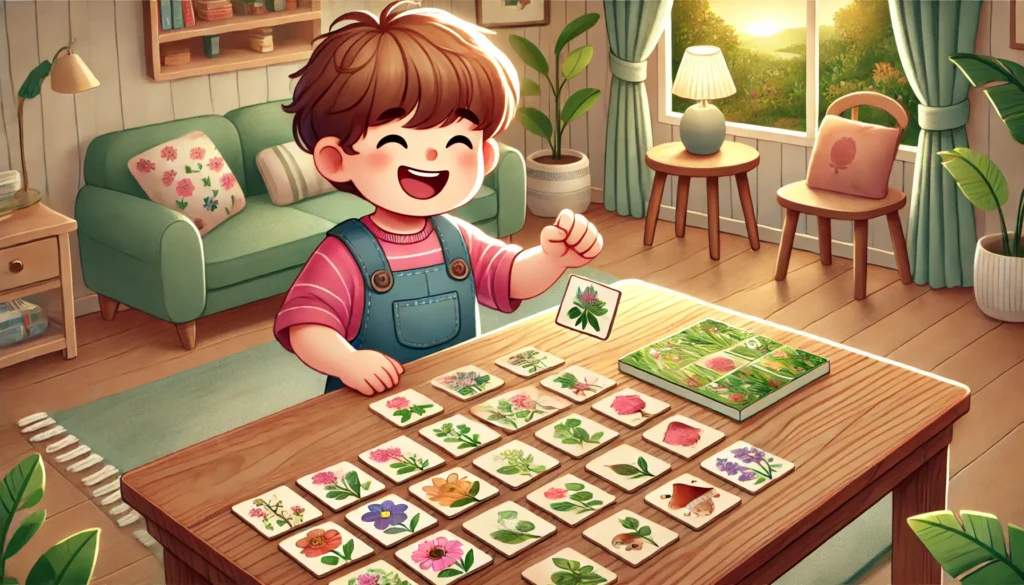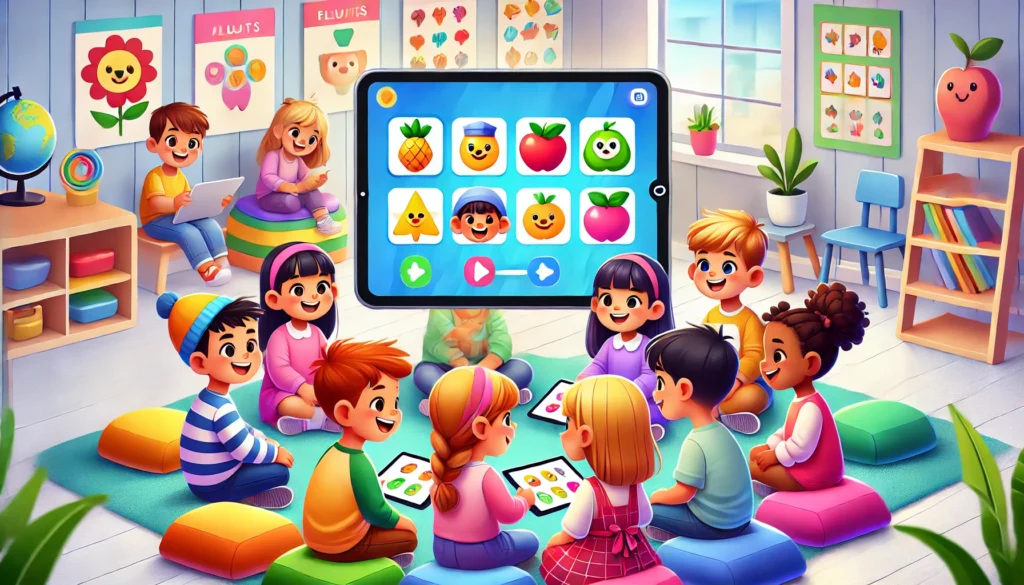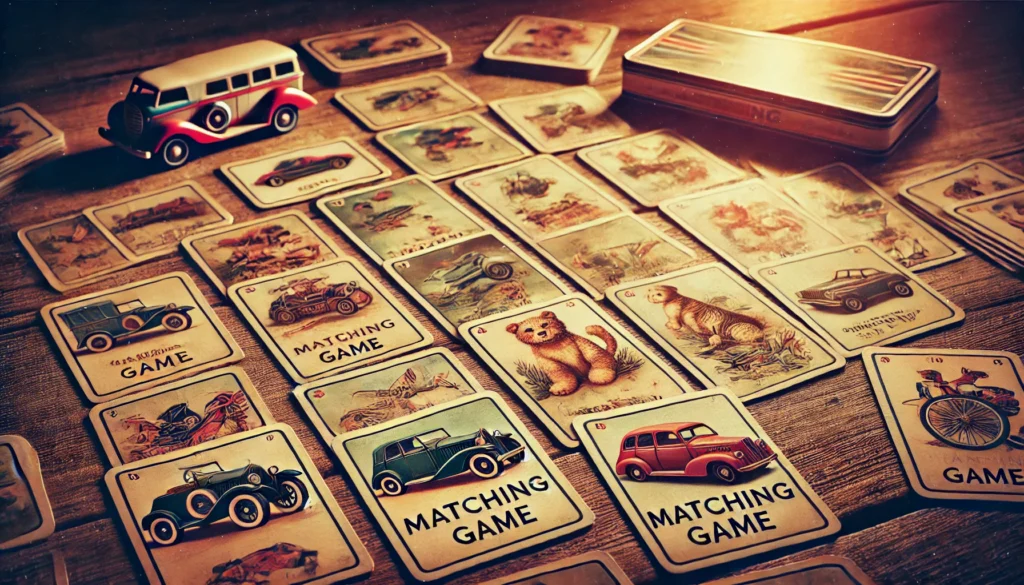In today’s fast-paced digital world, parents and educators are constantly seeking ways to engage children in meaningful activities that not only entertain but also enhance cognitive development. Matching games, often overlooked, are a powerful tool in this endeavor. These games, which challenge children to find pairs among a set of cards, images, or objects, are more than just fun—they are instrumental in developing memory, concentration, and other critical skills in young minds.
You may also like: Boost Your Mind: Top Brain Games
The Cognitive Benefits of Matching Games
Children playing matching games (“children playing matching games”) are engaging in much more than a simple pastime. These activities are gateways to significant cognitive development that can impact various aspects of a child’s growth. By involving them in matching games, we can leverage play to strengthen essential skills that are critical for lifelong learning.
Enhancing Memory Retention
Children’s memory games, such as “Memory” or “Concentration,” require players to remember the location of cards to find matching pairs. This process of recalling and recognizing patterns enhances memory retention. Studies have shown that engaging in memory games can lead to improved short-term memory and better retention of information in academic settings.
Moreover, the repetitive nature of matching games ensures that children regularly practice memory recall, which is a cornerstone of effective learning. This consistent practice supports not just immediate memory enhancement but also long-term retention abilities. As children progress through different levels of difficulty, they are challenged to remember more information, which gradually builds a strong memory foundation.
Additionally, memory games have been shown to help with the retention of non-academic information, such as daily routines and personal information. This generalization of memory skills underscores the versatility of matching games in everyday life.
Improving Attention and Concentration
Attention and concentration are vital skills for academic success, and matching games provide a fun way to develop these abilities. As children focus on finding pairs, they practice sustained attention—a skill that is crucial for tasks that require prolonged focus, such as reading or solving math problems.
Furthermore, matching games encourage selective attention, where children learn to filter out distractions and focus on the task at hand. This practice is essential in classroom settings where multiple stimuli can easily divert attention. By honing this skill through games, children can improve their ability to concentrate on lessons and assignments.
In addition to selective attention, matching games also enhance divided attention skills. As children manage multiple elements of the game, such as remembering card locations and strategizing their next move, they practice dividing their attention effectively. This skill is particularly beneficial in multitasking scenarios, both in academic and real-world contexts.
Developing Problem-Solving Skills
Matching games for toddlers and preschoolers also encourage problem-solving and critical thinking. As children play, they learn to strategize and think ahead, considering which cards to flip and remembering previous attempts. This kind of strategic thinking is an early form of problem-solving that is beneficial in numerous educational and real-world scenarios.
Through matching games, children also learn the value of perseverance and patience. They encounter challenges and setbacks when they do not immediately find a match, which teaches them to persist and try different approaches. This resilience is a crucial component of effective problem-solving.
Moreover, these games foster spatial reasoning skills, as children must visualize and remember the spatial arrangement of cards. This spatial awareness is a fundamental skill in fields like mathematics, science, and engineering, making matching games an excellent preparatory tool for future learning.

Historical Context and Evolution of Matching Games
Vintage matching game cards (“vintage matching game cards”) offer a glimpse into the rich history of matching games, which have been a part of human culture for centuries. From ancient times to the present day, these games have evolved significantly, reflecting changes in society and technology.
Ancient Origins and Cultural Significance
The concept of matching and pairing objects dates back to ancient times, with evidence of such games found in various cultures. In ancient China, games like “Pai Gow” involved matching tiles and were not only a form of entertainment but also a method of teaching strategy and calculation. Similarly, in ancient Egypt, board games with matching elements were used for both leisure and educational purposes.
Throughout history, matching games have been adapted to suit the cultural contexts of different societies. In medieval Europe, card games with matching elements were popular among nobility and commoners alike, serving as a social pastime and a means of sharpening mental acuity.
The cultural significance of matching games is evident in their continued popularity across generations. They have been used to pass down traditions, teach moral lessons, and foster family bonding, highlighting their role as more than mere entertainment.
The Rise of Digital Matching Games
In recent years, the advent of technology has transformed traditional matching games into interactive digital experiences. Free online matching games for toddlers aged 3 and above have become widely available, providing children with access to a plethora of engaging and educational content. These digital versions often incorporate colorful graphics and interactive features that captivate young learners while reinforcing essential skills.
Digital matching games have expanded the reach and accessibility of these activities, allowing children from diverse backgrounds to engage in cognitive development. They often feature adaptive learning technologies that tailor the difficulty and content to the individual child’s progress, ensuring personalized learning experiences.
Moreover, digital platforms have introduced innovative game mechanics, such as timed challenges and competitive leaderboards, which motivate children to improve their skills and achieve personal bests. These elements add an exciting dimension to matching games, making them more appealing to tech-savvy young audiences.
The Impact of Technology on Play
While some may argue that digital games detract from traditional play, research suggests that digital matching games can complement physical play by offering diverse learning experiences. They can introduce children to technology in a controlled environment, preparing them for future digital interactions while still focusing on cognitive development.
Digital matching games provide opportunities for collaborative play, where children can team up with peers or family members to solve puzzles and challenges together. This social interaction enhances communication and teamwork skills, which are crucial for success in both academic and personal contexts.
Additionally, the interactive nature of digital games can cater to different learning styles, offering visual, auditory, and kinesthetic elements that engage various senses. This multimodal approach to learning can be particularly beneficial for children with different learning preferences, ensuring that matching games remain inclusive and effective educational tools.
Current Trends in Matching Games for Children
The popularity of matching games has surged in recent years, with various versions tailored to different age groups and learning objectives. From simple toddler matching games to more complex memory games for kindergarteners, the options are vast and varied.
Personalized Learning Experiences
One of the emerging trends in matching games is the customization of content to cater to individual learning needs. Educational developers are creating games that adapt to a child’s skill level, ensuring that they are continually challenged and engaged. This personalized approach helps in maintaining interest and motivation, key factors in effective learning.
Personalized learning games often utilize artificial intelligence to analyze a child’s performance and adjust the difficulty and content accordingly. This ensures that children are neither bored by tasks that are too easy nor frustrated by challenges that are too difficult, optimizing the learning experience.
Moreover, these games can track a child’s progress over time, providing valuable insights to parents and educators about areas of strength and those requiring improvement. This data-driven approach to learning enables targeted interventions and supports a more individualized educational journey.
Incorporating Educational Themes
Many modern matching games incorporate educational themes, such as numbers, letters, animals, or colors, making them an excellent tool for reinforcing classroom learning. By integrating these themes, children can practice academic skills in a fun and engaging way, reinforcing what they have learned in school.
Educational themes in matching games are designed to align with curriculum standards, ensuring that the content is relevant and beneficial to a child’s academic development. This alignment allows educators to use games as supplementary tools to reinforce lessons and concepts taught in the classroom.
Furthermore, thematic games can introduce children to new subjects and areas of interest, sparking curiosity and a love for learning. By presenting information in an interactive and enjoyable format, matching games can inspire lifelong learning and exploration.
Encouraging Multisensory Engagement
Another trend in matching games is the integration of multisensory elements, which engage children through sight, sound, and touch. These games often include auditory cues, visual effects, and tactile interactions, catering to different learning styles and preferences.
Multisensory engagement can enhance the learning experience by reinforcing concepts through multiple sensory channels. This approach is particularly beneficial for children with diverse learning needs, as it provides various avenues for understanding and retaining information.
By incorporating multisensory elements, matching games can create immersive learning environments that captivate children’s attention and promote active participation. This holistic approach to learning supports cognitive development and fosters a deeper understanding of educational content.

Practical Advice for Parents and Educators
A teacher guiding children in a matching game (“teacher guiding children in a matching game”) illustrates the importance of selecting and using matching games effectively to maximize their educational benefits. Choosing the right games requires careful consideration of age, skill level, and educational goals.
Age-Appropriate Selection
Ensure that the games are suitable for the child’s age and developmental stage. For toddlers, simple games with fewer elements are best, while older children can handle more complex challenges.
Age-appropriate selection involves understanding the cognitive and emotional development milestones of different age groups. For younger children, games with bright colors, simple patterns, and clear instructions are ideal, as they match their developmental capabilities and attention spans.
For older children, more complex games that require strategic thinking and problem-solving can provide the necessary challenge to stimulate growth. These games can introduce advanced concepts and skills, preparing them for more demanding academic tasks.
Balancing Screen Time
While digital games are beneficial, it’s essential to balance screen time with physical play. Encourage children to engage in both digital and traditional matching games to provide a well-rounded learning experience.
Balancing screen time involves setting clear boundaries and schedules to ensure that children have ample opportunities for physical activity and social interaction. This balance helps prevent the negative effects of excessive screen use, such as eye strain and reduced physical fitness.
Parents and educators can incorporate traditional matching games into daily routines, providing opportunities for hands-on learning and social engagement. These activities can complement digital games, offering diverse experiences that cater to different aspects of development.
Encouraging Cooperative Play
Matching games can also be a social activity. Encourage children to play with peers or family members, which fosters teamwork and communication skills.
Cooperative play in matching games promotes social interaction and helps children develop essential interpersonal skills, such as sharing, turn-taking, and conflict resolution. These skills are crucial for building positive relationships and navigating social environments.
By playing matching games together, children can learn from each other, share strategies, and collaborate to achieve common goals. This teamwork fosters a sense of community and belonging, enhancing the overall learning experience.
Future Implications and the Role of Matching Games in Education
As education continues to evolve, matching games are likely to play an increasingly significant role in early childhood development. Their ability to engage children while promoting cognitive skills makes them a valuable tool for educators and parents alike.
Integrating Matching Games into Curricula
Educators are beginning to recognize the value of incorporating matching games into curricula as a means of reinforcing learning objectives. By aligning games with educational standards, teachers can use them to supplement classroom instruction effectively.
Integrating matching games into curricula involves designing lesson plans that incorporate games as active learning tools. Teachers can use games to introduce new concepts, review material, or assess understanding in a dynamic and interactive manner.
Furthermore, matching games can be used in various subjects, from language arts to mathematics, providing versatile tools for educators to enhance student engagement and achievement.
Advancements in Game Design
As technology advances, the design of matching games will likely become more sophisticated, offering even more personalized and interactive learning experiences. This evolution will ensure that matching games remain relevant and effective educational tools for future generations.
Advancements in game design may include the use of virtual and augmented reality to create immersive learning environments. These technologies can enhance the realism and interactivity of games, making learning more engaging and impactful.
Additionally, future game designs may incorporate more advanced artificial intelligence to provide real-time feedback and adapt to the unique learning styles of each child. This personalization can optimize the learning experience, ensuring that games meet the diverse needs of all learners.

Expanding Accessibility and Inclusivity
As matching games continue to develop, there is a growing emphasis on expanding accessibility and inclusivity to ensure that all children can benefit from their educational potential. Game developers are focusing on creating inclusive designs that accommodate diverse learning needs and abilities.
Inclusive matching games may feature customizable settings, such as adjustable difficulty levels and alternative input methods, to cater to children with different capabilities. This approach ensures that all children, regardless of their abilities, can participate and learn effectively.
By prioritizing accessibility and inclusivity, matching games can reach a broader audience and provide equitable learning opportunities for children worldwide, supporting diverse educational experiences and outcomes.
In conclusion, matching games are more than a simple pastime. They are a powerful educational tool that can significantly enhance a child’s cognitive development. By incorporating these games into daily activities, parents and educators can provide children with a fun and effective way to boost their skills and prepare them for future learning challenges.
Further Reading:
7 games to help your child master matching
Important Note: The information contained in this article is for general informational purposes only, and should not be construed as health or medical advice, nor is it intended to diagnose, prevent, treat, or cure any disease or health condition. Before embarking on any diet, fitness regimen, or program of nutritional supplementation, it is advisable to consult your healthcare professional in order to determine its safety and probable efficacy in terms of your individual state of health.
Regarding Nutritional Supplements Or Other Non-Prescription Health Products: If any nutritional supplements or other non-prescription health products are mentioned in the foregoing article, any claims or statements made about them have not been evaluated by the U.S. Food and Drug Administration, and such nutritional supplements or other health products are not intended to diagnose, treat, cure, or prevent any disease.


